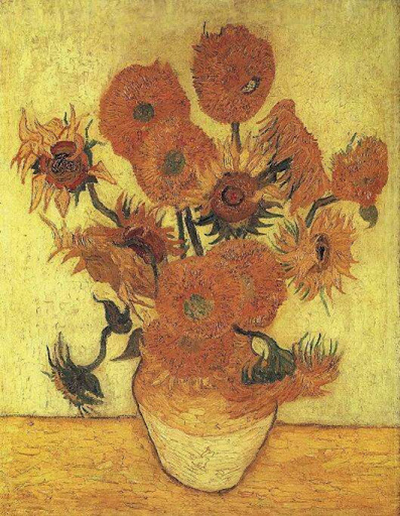Any art lover will know that arguably Vincent Van Gogh's most famous works are those containing sunflowers. Painted in Arles during the height of summer in 1888, the series of sunflower paintings mark a prominent and defining chapter in the career of the artist; one symbolised by loneliness and increasing confusion.
In an attempt to record the vivid colour changes of his move from Paris to Provence, Van Gogh honed in on sunflowers, in particular, to play with the different tones and shades that his new environment was providing; he was even quoted as saying that it wasn't until he arrived in Arles that he had truly seen colour before.
One of a series of famous sunflower centric paintings, Vase With Fourteen Flowers very much reflects Van Gogh's preference for the colour yellow, a favourite, that to him, represented the very essence of warmth and summer. The painting depicts a vase of sunflowers, all of varying shapes and dimensions, facing many different directions out of a colour complementary vase.
Van Gogh painted two series of sunflowers. One set was painted in Paris, and the flowers are depicted lying on the ground. The second set was painted in Arles. There are four paintings in this set, with this particular one being the last of them. When comparing the set, you can see that this final attempt marks the last of the sunflowers' beauty before they begin to fade. In a meta sense, parallels can be made between the fading life of the flowers and the fading will to live of the artist.
Something of note in the painting's composition is Van Gogh's choice not to use purple, the customary complementary colour of yellow, but rather a variation of blue instead. This seemingly unnoticeable change of convention is yet another example of the small ways in which Van Gogh was challenging and changing the norm and culture of art, perhaps without even realising it at the time. Another theory behind this decision of blue over purple is the fact that it was also a commonly used technique by Vermeer, a painter who was very much on Van Gogh's mind during his time spent in Arles in the late 19th century.
Whilst some of his more recognisable self-portrait work might be more standout in terms of analysis and prestige, there is no doubting that the sunflowers series, and Vase With Fourteen Flowers in particular, has a lot to say about the defining style, sensibility, and vibrant relationship with colours that have come to be seen as 'classic' Van Gogh.




